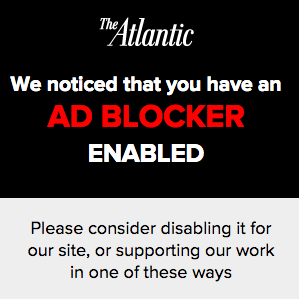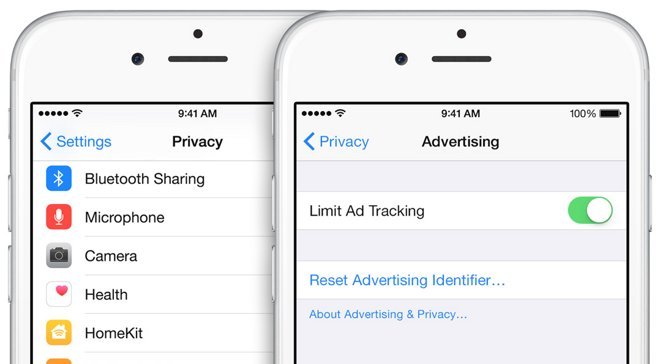This is a collection of articles and blog posts about the coming “nuclear winter” for online content if we can’t find a way to compensate publishers and creators.
A way off the ranch

April 1, 2016 — Doc Searls
Once we were human, and now we are cattle. We go to websites for the milk of content and get cookies that track us like animals.
The New York Times clearly isn’t fixing the problem. Nor is the advertising business, which Bob Hoffman nails in Bullshitters bullshitting bullshitters, his report on a recent ad industry gathering:
[In a recent panel discussion about ad blocking] the agencies blamed the publishers, the publishers blamed the agencies, everyone blamed clients for not paying enough for the crap they’re being sold or consumers for not understanding the terrible plight of the virtuous online publishers.
Internet Identity Workshop
Clearly it is time for us—the readers—to rescue ourselves, the publishers and the advertisers, for the good of everybody. We can do this by providing a way for THEM to agree to OUR terms, rather than the reverse.
Publishing is a perfect place to start this work, because the it creates a good deal for both sides. Publishers get to make money the way they always have, and readers get their privacy back. Advertising is worth more as well, because its signals are uncompromised by suspicions about it.
Mozilla co-founder's ad-blocking Brave browser will pay you bitcoin to see safe ads
April 1, 2016 — Jared Newman | @onejarednewman, PCWorld
Why this matters: As ad blocking becomes more common on the web, Brave is seeking a middle ground between compensating publishers for their work and protecting users from cumbersome, invasive, and sometimes dangerous ads. Whether advertisers and publishers get on board remains to be seen, but with the ad industry admitting that it has alienated users over the years, perhaps they’ll be receptive to novel solutions like the one Brave is offering.
Opera And The Browser Ad Block Bandwagon
March 15, 2016 — McSolo
...the Opera version [37] with a built-in ad blocker is a new developer project that should tell us where browsers of the future are going. The ad blocker bandwagon is here...
In 2014 9-percent of readers also blocked ads.
In early 2015 it was 19-percent.
This year [as of March 2016] it’s 31-percent.
That means nearly one of every three visitors to McSolo uses an ad blocker.
Opera merely added what users say they want. No. More. Ads. Or, in the alternative, a way to control the ads and JavaScript trackers which have become burdensome in recent years. Burdensome? Yes. Ads and their tracking scripts can increase the size of a website by an order of magnitude.
==How long before Apple and Mozilla put an ad blocker option into Safari and Mozilla? ==
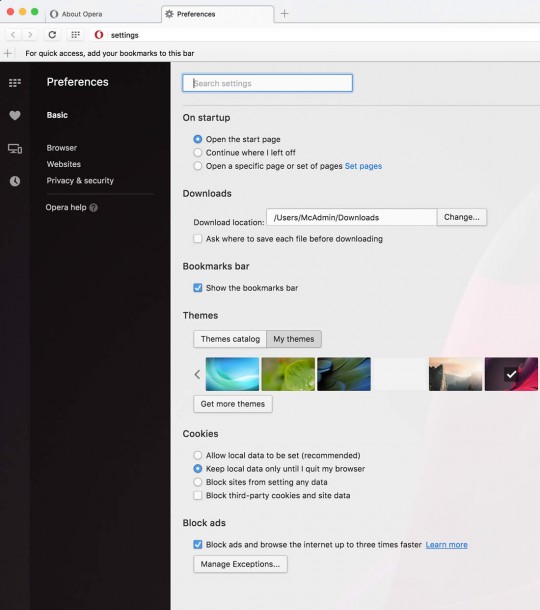
Ad blocking is a built-in feature in Opera 37 developer version.
Also: Opera's testing a browser that kills ads, accelerating webpage loading by up to 90 percent
Ad Blockers Are Making Money Off Ads (And Tracking, Too)
March 3, 2016 — JULIA GREENBERG — Wired
ADVERTISING PAYS FOR a lot of what you see on the Internet. This makes ad blockers a big deal. Readers are using them. Advertisers are panicking about them. Publishers are attempting to quash them. Meanwhile, ad blockers market themselves as a way to speed up web browsing while you skirt evil data collectors and attention-hungry advertisers. But ad blockers are running businesses too. And their business models aren’t too far off from the very ones that publishers and advertisers use to make money on the web.
This former ad agency CEO says the ad industry has 3 major delusions holding it back
Will Heilpern @willheilpern - March 1, 2016 - Business Insider
- The brand delusion - The first mistake advertisers make is thinking that other people actually care about their brands.
Creating a strong brand should be every marketer’s primary objective... [but] there’s a widespread belief in our business that consumers are in love with brands. That consumers want to have brand experiences and brand relationships and be personally engaged with brands and read branded story telling.
People have shaky jobs and unstable families, they have illnesses, they have debts... they have a lot of things to care deeply about. It’s very unwise to believe that they care deeply about our batteries, our wet wipes and our chicken strips.
- The digital delusion - The next false belief that Hoffman says is damaging the ad industry is the over- exaggeration about the importance of digital.
It was going to kill advertising, it was going to kill traditional marketing, it was going to kill everything in its path... [but] every square inch of the f------ planet is covered in advertising.
[With digital, marketers] don't know what they're buying, they don't know who they're buying it from. They don't know what they're getting, they don't know how much they're paying.
- The age delusion - He thinks the advertising industry is far too concerned with grabbing young people's attention, when, in reality, the most lucrative market is the over 50s.
You know all the awesome millennials we see in car ads? In the US, people aged 75 to dead buy six times as many new cars as people aged 16 to 24. Do you really think it's a good idea to avoid these people?
Why Apple Won’t Buy Yahoo!
Wednesday, February 24, 2016 - Tera Talks
Content is now so abundant that it is worthless
There once was a time when content– that derived from newspapers, magazines, local TV stations, radio stations, and network TV and radio stations– was valuable.
Today, thanks to the internet, people are swimming in free content. No. Maybe we’re drowning in free content and it is increasingly difficult for content to standout from other content sufficient to make any real money. That means there’s a consolidation of content providers taking place all over the world.
The content landscape is littered with mediocre content manufacturing schemes, all designed to attract readers and eyeballs, all designed to force more advertising into a readership already ill with both ridiculously banal content and offensive, in-your-face advertising.
Sites detect ad-blockers
February 2016 updated July 3, 2016
More and more sites are detecting ad blockers and asking them to be turned off.
As Medium plans to start using advertising, they begin detecting ad blockers:
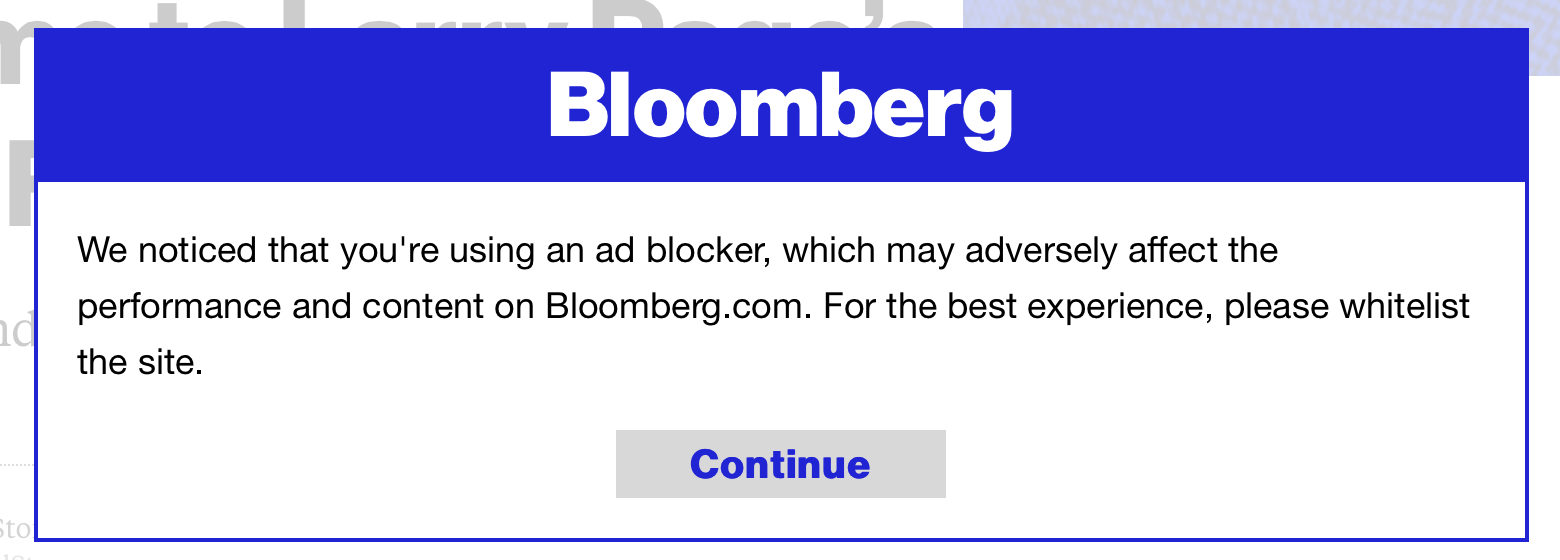

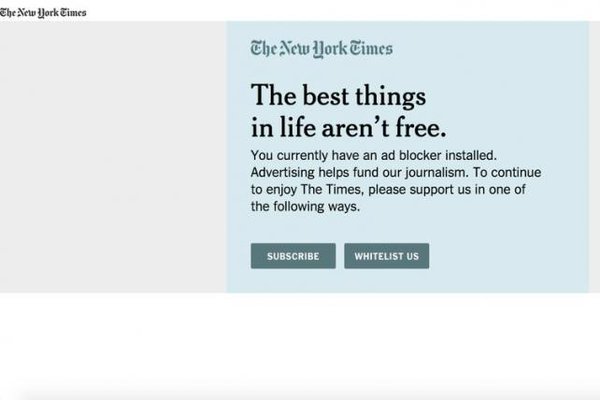
For what it's worth, I subscribe to the New York Times, and this image comes from Twitter.

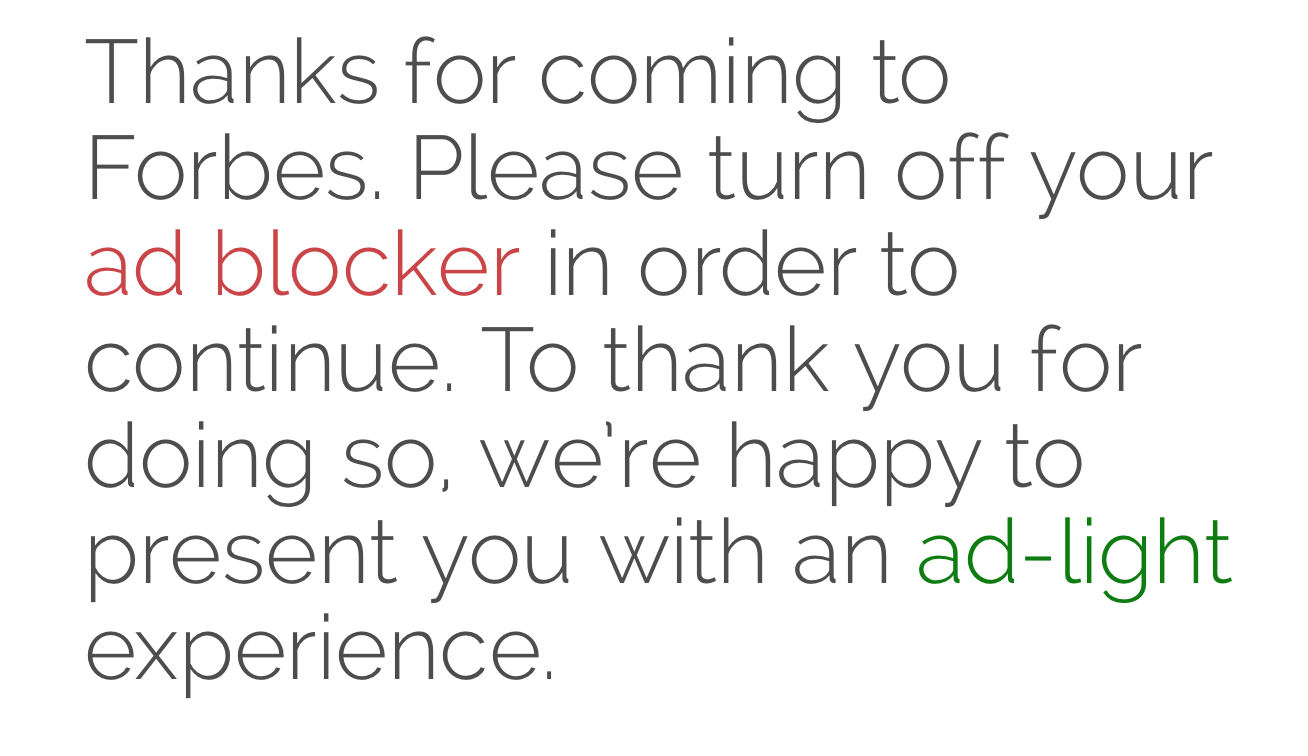
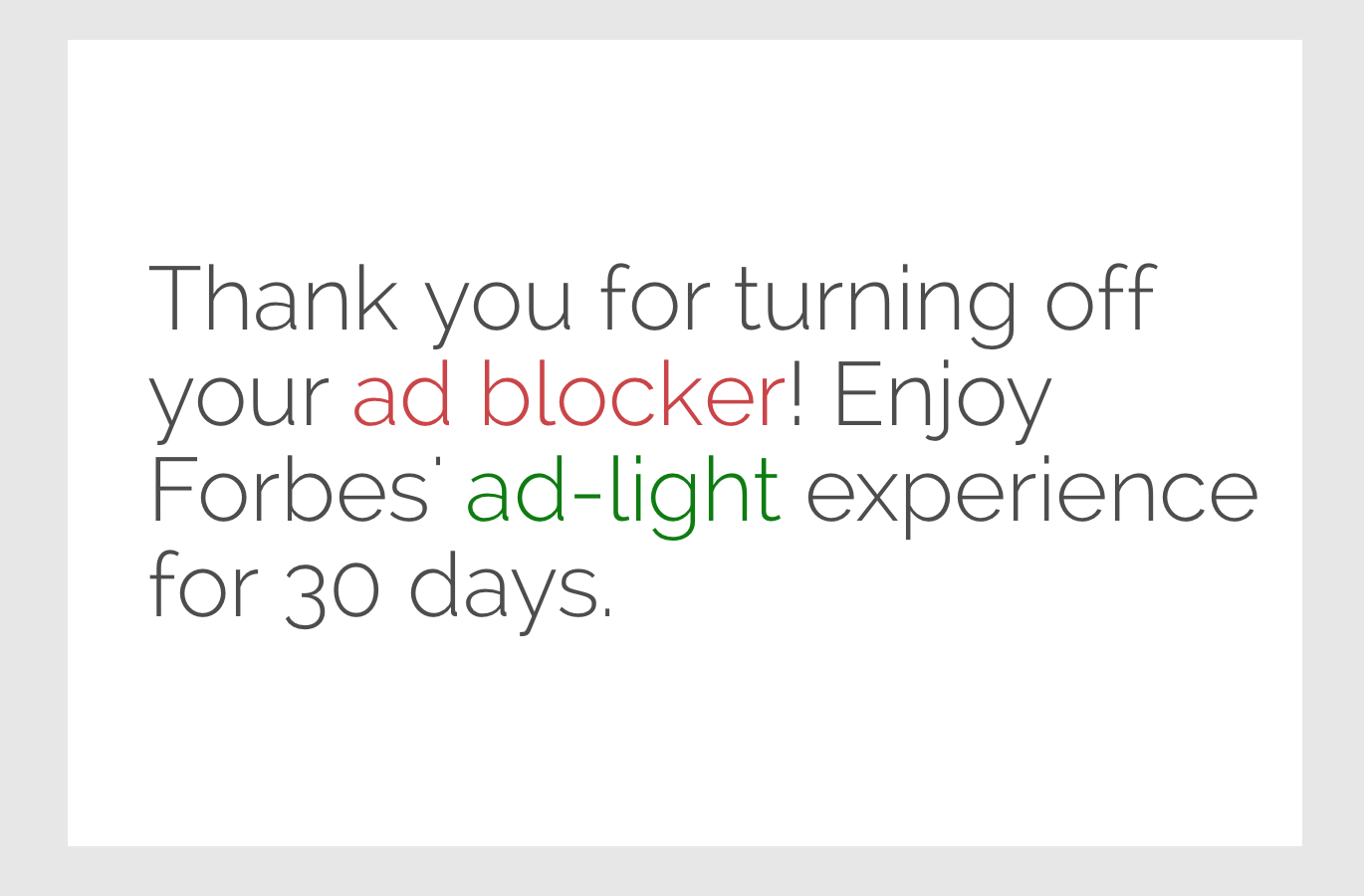
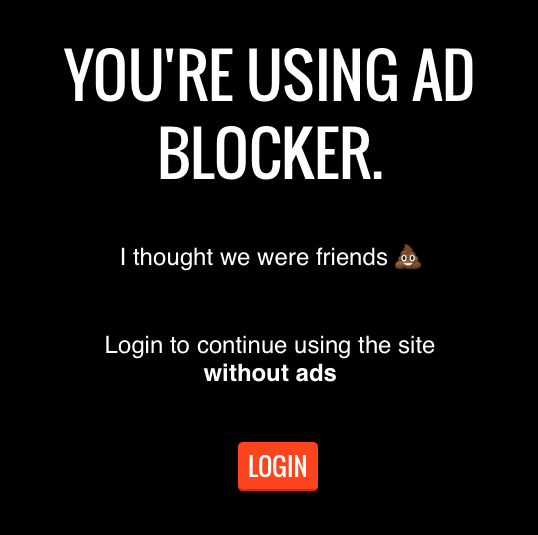
Three Reasons Why Ad Blocking Will Benefit Everyone
Oct. 21, 2015 — Forbes
- Technology is enabling a more efficient customer experience.
- Brands can give algorithms & hyper targeting a human touch.
- It’s another step forward toward a much better online experience.
Digital marketing has deep roots in fraudulent activities and trumped up metrics. A lot of the behavior we hear about today–sketchy metrics, fake volumes and advertising display, agencies that are impressions hungry–have been around since companies started using digital marketing tactics in earnest in the mid-to-late 90s. Ad blocking will change those dirty habits.
How WIRED Is Going to Handle Ad Blocking

Adbloqueurs : l’internet libre et gratuit est en danger
Depuis plusieurs années, les internautes ont lancé un mouvement dont ils ne semblent pas anticiper les conséquences. Si la tendance se confirme et que nous ne parvenons pas à trouver un compromis, ce sera bientôt la mort de l’internet libre et gratuit tel que nous le connaissons aujourd’hui.
IAB head: 'we messed up' in escalating Internet advertising technology
In a blog post, Scott Cunningham, the senior vice president of technology at the Interactive Advertising Bureau (IAB), confessed to driving the state of Internet ads to near collapse. Saying that the rampant proliferation of Flash and similar technologies has "steamrolled the users, depleted their devices, and tried their patience", the vice president has launched the LEAN ads program, designed to lighten the impact on users, reduce the data footprint of ads, and guarantee viewer device safety simultaneously.
The Cost of Mobile Ads on 50 News Websites
October 1, 2015
The New York Times tests 50 websites to see how ads really affect performance.
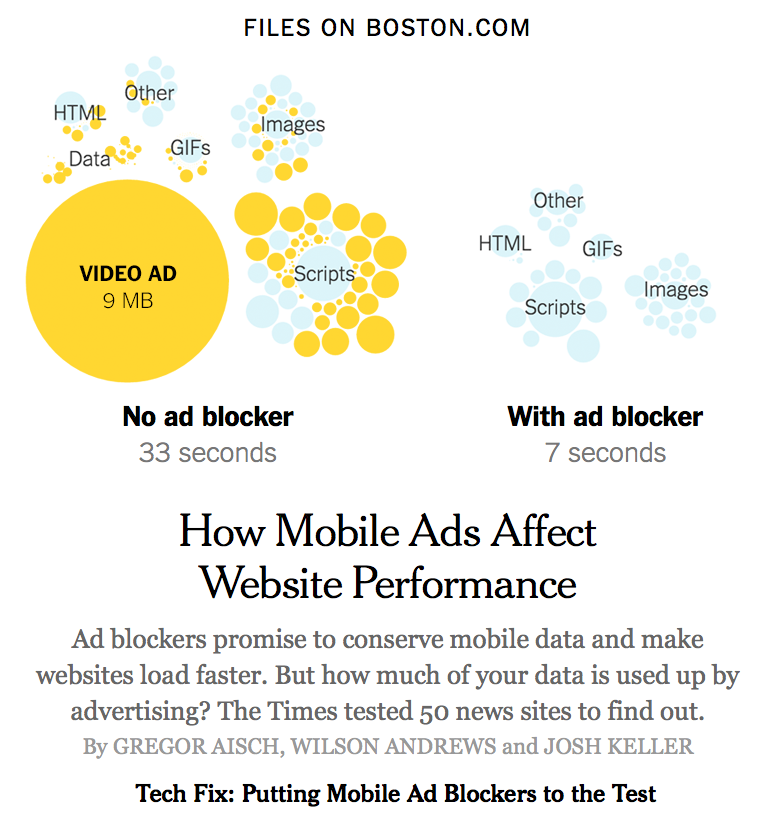
[Ad-blockeing software] Peace founder pulls iOS 9 ad blocking app because he feels guilty
September 21, 2015 — Dave Neal, The Inquirer
"Achieving this much success with Peace just doesn't feel good, which I didn't anticipate, but probably should have. Ad blockers come with an important asterisk: while they do benefit a ton of people in major ways, they also hurt some, including many who don't deserve the hit.
"Peace required that all ads be treated the same - all-or-nothing enforcement for decisions that aren't black and white," he added.
Apple is killing the open web and the media has only itself to blame
September 21, 2015 — Brad Reed, BGR
Yes, I’ll say it: Publishers and advertisers bear the majority of the blame for this fiasco. In short, we in the news media have allowed our websites to get overloaded with aggressive ads that take over the entire page, that slow down page load times and that suck up far more data than they otherwise should. These ads degrade user experience and go far beyond what any reasonable reader should have to endure, even if we are giving them content for free.
A Few Words About Ad Blockers
We conducted tests on Mac360 in recent months and found that nearly 25-percent of all visitors blocked the few ads we have remaining on the site (we once ran as many as 18 ads; now there are three). Ad blockers are accused of blocking website revenue, too, so there is a danger that smaller publishers could go out of business unless there is an alternate method to obtain revenue. Indeed, our monthly advertising revenue, now mostly from Google, has declined precipitously in the past few years. The same has happened elsewhere on websites all over the internet, and it’s about to get worse.
What’s the solution?
We’ll take suggestions.
The Many Ways I Avoid Ads
September 21, 2015 — Kirk McElhearn
If you think that blocking ads on websites is wrong, tell me how many of the following actions you take to avoid ads.
- I turn off the volume when TV commercials are on
- I go to the bathroom when TV commercials are on
- I skip through commercials when watching recorded TV
- I throw away junk mail without looking at it
- I throw away inserts with magazines I subscribe to without looking at them
- I throw away ad sections of newspapers when I buy them
- I turn the pages of magazines and newspapers too quickly to assimilate ads
- I don’t look at ads on the sides of busses
- I ignore billboards with ads when driving
- I avoid televised sports, because there are too many ads
- I hang up on robo-calls
- I avoid buying clothes with logos when possible
- I ignore the ads on the back of supermarket receipts
- I delete spam emails
- I use a pop-up blocker with my web browsers
- I use a tracker blocker (Ghostery) with my web browsers
- I use an ad blocker with my web browsers
- I use Safari’s Reader view to be able to read pages that are too cluttered
I remember when a one-hour TV show in the US was 52 minutes long; it left eight minutes for ads and station identification. Now, a one-hour show has 42 minutes of content, which means that 30% of the hour is commercials. Viewers adapted to this by recording shows and skipping ads, and the same is happening on the web.
Apple's Ad Blocking: Is This The New Piracy?
September 21, 2015 — Bill Rosenblatt, Forbes
Ads are dead, long live ads!
September 21, 2015 — Marko Savic, CEO at FunnelCake @getfunnelcake
When Microsoft made pop-up blockers the default in IE in 2004, everyone thought web publishers were screwed — how’s anyone going to make money? But the web didn’t die. Instead new ad formats appeared, specifically native ads and programmatic advertising.
Does this all sound familiar? That’s because we’re at the beginning of the next upheaval.
If you built your new media empire in the last few years on programmatic advertising, stop whining. You’re building a business. If your revenue model relies on a few snippets of code that can be blocked with a software update, you’re not building a very good business.
It’s truly incredible that anyone from an indepedent blogger to The New York Times can use the same ad networks, their revenue restricted only by pageviews... On the other hand, publishers stopped thinking about their business model.
Publishers forgot how to sell. In the booming days of print, The New York Times and Condé Nast would have had amazing in-house sales teams selling placements perfectly paired with seasonality and content.
As users block ads in droves and fraudulent ads eclipse legitimate ones, online media’s final source of revenue is gone, and no one has a good solution
“I see you are blocking ads. Maybe you want to support us another way?”. — Joop Kiefte, The Guardian
It's the End of the Line for the Ad-Supported Web
Sept. 21, 2015 — Dylan Tweney, Tweney Media, Venture Beat
The thing is, there’s not even really a debate about ad blocking.
It’s coming[it's already here], whether advertisers and publishers like it or not.
The story, in a nutshell, is that readers are finally getting fed up. Fed up with incessant banner ads, obnoxious pop-ups, and videos that automatically start playing when you load a page. Fed up with fullscreen takeovers that force you to find, and click, a tiny “x” before you can read the article you actually came for. Fed up with cookies and widgets that track their every move online, allowing advertisers to target them with increasing precision. Did you look at an underwear website a few weeks ago? You’re going to be seeing ads for underwear every time you visit Facebook — or any of dozens of other sites...
Publishers allow these ads because they need the revenue from advertisers. For a decade and a half, the predominant business model for online publishers — not to mention gigantic platforms like Google and Facebook — has been advertising. The problem is that, thanks to the law of supply and demand, the value of advertising has been steadily decreasing over the past 15 years. Advertising is sold based on impressions, or the number of times that people have seen it (or are assumed to have seen it). As web use goes up, people see more web pages, and that means publishers are delivering more impressions. As the number of impressions approaches infinity, the value of those impressions approaches zero.
For publishers, that means that ad revenues have been steadily decreasing for years. The most obvious response is to try to increase the number of impressions to offset their declining value.
There are two ways to do that: Increase traffic, and put more (and more intrusive) ads on each page. The first strategy leads to BuzzFeed-like clickbait and desperate reblogging of the stories deemed to have the most traffic potential [to go viral]. The second leads to ad-choked pages and increasingly in-your-face advertising.
A third approach is to try selling native advertising: Ads disguised as content, so ad-blockers can’t block it and readers are confused about whether they’re reading independent content or an ad. Lots of publishers are embracing this model, and advertisers love it, for obvious reasons. Readers, however, find native ads obnoxious, because their implicit value lies in deception.
There are two other strategies available to publishers, but they haven’t worked in most cases. One is to try to stay above the fray, offering premium content in search of higher-value advertising aimed at a more premium audience. That works, but only if the publisher has a truly premium audience (like Techmeme) or enough scale to build out a network of sufficient size to get advertisers to take it seriously (like Vox Media).
The economic forces governing Web advertising have led us to a point where ads are out of control, and readers have no choice but to take measures to protect themselves and their bandwidth.
For publishers that are dependent on ads, that means a very grim future indeed. The question is, can they evolve new business models in time?
Enabling of Ad Blocking in Apple’s iOS 9 Prompts Backlash
Just two days after Apple enabled ad-blocking apps through its new mobile operating system, iOS 9, users are embracing the new technology after long complaining that the ads track them, slow down web browsers and are just plain annoying. In less than 48 hours, several ad-blocking apps with names like Peace, Purify and Crystal soared to the top of Apple’s App Store chart.
Yet some web publishers are now fretting that ads on their sites can’t be viewed because of the blockers, which could threaten these publishers’ livelihoods. On Friday, the maker of the $3 ad-blocking app Peace, Marco Arment, removed his program from the App Store and offered refunds, saying that while stopping ads does “benefit a ton of people in major ways, they also hurt some, including many who don’t deserve to be hit.”
Self-Important Pop-Up Ads Aren’t Nearly as Clever as They Think They Are
Ad blocking is not “because of Apple”
September 16, 2015 — the day iOS9 is released
The coming reckoning for publishers is not “because of Apple”. It’s because of the choices the publishers themselves made, years ago, to allow themselves to become dependent on user-hostile ad networks that slow down the web, waste precious device battery life, and invade our privacy. Apple has simply enabled us, the users who are fed up with this crap, to do something about it. If aggressive content blocking were enabled out of the box, by default, I could see saying the result is “because of Apple”. But it’s not. ==What’s about to happen is thus because of us, the users [who chose to block ads].== — Daring Fireball
iOS 9: How to use the Purify ad blocker
Sept 15. 2015 — one day before iOS9 is relased
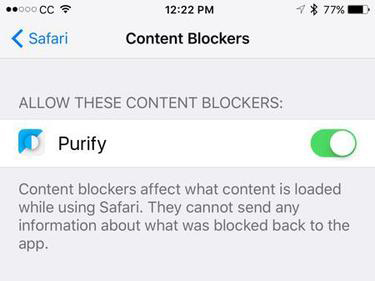
Purify allows “whitelisting” sites you like, so you can help keep them in business, while blocking ads on other sites.
Once you’ve added the Purify Whitelist button to the regular Sharing menu, it’s very quick and easy to whitelist your favorite sites. They’ll appreciate your continued support and you’ll feel glad that you’re doing your part to help them stay in business.
So far I’m pleased with the Purify ad blocker. It definitely makes Web pages load faster, and it gets rid of annoyances like popup ads, etc. Browsing the Web on my iPhone 6 Plus with Purify on is certainly a better overall experience.
Websites are learning how to block ad blockers, and round and round we go
Sept. 12, 2015
The Washington Post is stepping up its defenses by actively striking back at ad blockers. The newspaper is testing out a feature that stops readers with ad blockers enabled from viewing an article until they agree to sign up for an email newsletter or subscribe.
"Many people already receive our journalism for free online, and in the long run, without income via subscriptions or advertising, we won’t be able to deliver the journalism that people coming to our site expect from us," Post spokesperson Kristine Coratti Kelly said in an email.
”Hey, we’re the publisher, we’d love to give you content, please choose how’d you’d like to compensate us”
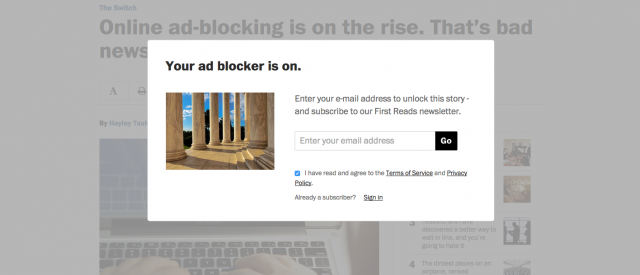
Sept. 2, 2015 — Graphic News

Paywalls don’t work for newspapers except for a few exceptions, like The Wall Street Journal, which is the source for financial information. And many of their articles are free. But people certainly can’t be expected to subscribe to each and every source of news we are used to visiting each day. A different login for each site, different billing... it’s just a hassle, even if we want to support journalism.
It’s like before iTunes, when people wanted to buy music legitimately, but it was not as convenient as downloading from Napster. iTunes isn’t perfect, but it is convenient, and people are making money.
Part of the problem is that most news sites that need to pay journalists are competing with "viral" "news" sites like Buzzfeed that make money from advertising — and deliver much of the same news. Making money from ads on the web requires massive volume, so that local story that only a few thousand people care about just costs too much to produce.
Can journalism unite to simplify subscription?
A possible solution is some kind of group subscription like Spotify and other streaming music models. Imagine paying a certain monthly fee to then have access to all the news sites out there, from the New York Times to your local newspaper. You just have to get news sites to participate in this centralized “Spotify for news”. One all-access subscription to news.
But I haven’t looked at the numbers. I doubt that it would be profitable. And in a way, it ends up being an Internet tax, if all the news sites require you have a monthly pass. And the more organizations that join, the more the profits are divided up, and/or the fee increases.
I don’t mind advertising but I do mind tracking. What do I do?
Sept. 4, 2015
There are three types of users:
- Users who want to block ads
- Users who want to block tracking
- Users who want to block both (ads + tracking)
I am not convinced that blocking of ads (ad-block) on the Internet is a good thing. I am convinced that blocking of tracking on the Internet is a good thing for people who do not want to be tracked.
One of the ideas that surfaced from my team was around highlighting the advertisement (or the URL [awesome] bar) with a specific color so the user knows something is happening related to tracking.
Example: If ad + tracking is rendered to user, URL bar turns yellow. If yellow, the user can click and see why.
The content business is in for a nuclear winter if we don’t find a way to directly and/or indirectly compensate publishers and creators.
— Darren Herman, VP of Content Services at Mozilla.
Should a new (or any) user be required to turn off their ad blocking software in order to use a platform?
August 24, 2015
Go to the profile of Dan Pupius
What if ad-blockers are incorrectly blocking legitimate resources that Medium needs to function correctly? We can’t control the block list. — Dan Pupius
One of my concerns is that a new user won’t know there is a content block they aren’t seeing… — Timothy S. Boucher
Absolutely. We’re not happy with the situation and trying to work with the ad blockers. But we have limited ability to react. — Dan Pupius
Apple’s ad blockers rile publishers
30 Aug. 2015 — Yahoo Finance
Apple says it won’t allow ad blocking within apps, because ads inside apps don’t compromise performance as they do on the browser. That distinction serves Apple’s interests. It takes a 30% cut on money generated from apps, and has a business serving ads inside apps.
What’s more, iOS 9 will include an Apple News app, which will host articles from major news publishers. Apple may receive a share of the revenue from ads that accompany those articles.
It seems Apple’s answer to ad-blocking is for news organizations to sign up with their ==Apple News service. Facebook also has a similar "instant articles" feature== with revenue sharing. Does this mean publishers are now dependent on Apple and Facebook to make a living? Until iOS9 comes out, it’s all speculation. But Facebook’s instant articles is a hit. And if the trend continues and publishers get revenue sharing, they will adopt it.
Users have become accustomed to accessing the wealth of “free” content on the web, not comprehending that someone, somewhere needs to be paid to create the content they enjoy. — LostSociety
The market for attention is saturated, and the buyer is not very sophisticated yet. It’s early in internet history, & we (the buyers) are gluttons, & not discriminatory. We just discovered sugar. — Emilie Mitcham
The Alleged $7.5 Billion Fraud in Online Advertising
22 June 2015 — Mozilla Foundation
“This is the biggest advertising story of the decade, and it’s being buried.” — Bob Hoffman, retired CEO and chairman of Hoffman/Lewis Advertising
An entire industry—billions of dollars and thousands of jobs—is at stake.
25% of online ad impressions are allegedly fraudulent.
AdWeek, 2013
We start with the notion that only 15% of impressions ever have the possibility to be seen by a real person. Then, factor in that 54% of ads are not viewable (and we already discussed how flawed that metric is), and you’re left with only 8% of impressions that have the opportunity to be seen by a real person. Let me clarify: That does not mean that 8% of impressions are seen. That means only 8% have the chance to be seen. That’s an unbelievable amount of waste in an industry where metrics are a major selling point.
Essentially: If you have an online display ad budget of $100,000, then only $8,000 of that ad spend has the chance to put advertisements in front of human eyeballs. (And that’s not even taking into account the poor clickthrough rates of display ads when people do see them.)
If you are paying $0.10 per impression, then the $10,000 that you will pay for 100,000 impressions will result in only 8,000 human views—meaning that the effective cost per impression (CPI) will actually be $1.25.
Why is no one talking about this?
No marketing agency wants clients to know that 92% of its display advertising spend is wasted. No advertising manager wants the CMO to know that only 8% of the company’s ads are reaching people at 100% cost. No CMO wants the CEO to know that 92% of the entire ad budget is being flushed down the digital toilet.
Google, to its credit, has disclosed that 56% of its digital ad impressions are never actually seen.
There’s a ticking time bomb inside the online advertising market
1 July 2015 — Fortune, by Mathew Ingram @mathewi
Traditional ads in print newspapers and magazines and other formats, were notoriously difficult to measure. As a result, media companies were able to charge huge sums based on the assumption that lots of people saw an advertiser’s message.
In other words, the golden age of publishing depended on the fact that advertisers couldn’t tell if it worked. Newspapers were a "cash cow" in this era, charging $25,000 for a full-page ad. (Kansas City Star, circa 1995)
The Internet was supposed to improve this because advertisers can track the user’s behaviour. But A study by comScore in 2012-2013 concluded that 54% of ads weren’t shown to a human visitor. Software programs designed to mimic the activities of human browsers can scroll through a site and click on links, just as a human browser would. As much as 60% of the traffic on the Internet is non-human (According to a December 2013 report in The Atlantic).
The online advertising market is like a house of cards that is ready to topple—or a tiny child’s bicycle being ridden by dozens of clowns, all perched on each others’ shoulders. How long before it collapses completely?
Half of all online ads are never seen by a human being, huge amounts of traffic and clicks come from bot networks, and fraud is rampant.
advertising revenues continue to fall—not just for print, but for digital and video and pretty much everything. But there’s an even bigger problem for ad-based media that doesn’t get talked about much: Namely, the fact that a massive chunk of the advertising market is based on smoke and mirrors, or even outright fraud.
We are three clicks away from an "oh shit" moment
22 July 2015 — Darren Herman, the VP of Content Services at Mozilla:
We could be one minute away from deletion of the dominant monetization currency of the web: advertising. If this happens, over $50,000,000,000 advertising dollars in the US will vanish.
Internet users have a myriad of easy-to-use tools to block ads. Users are installing anti-advertising add-ons at a high rate. I’ve seen numbers from industry participants stating that ad blocking is growing at 43% per year.
If we look at how tv ads sell, [television advertisers] take ad skipping into account in the sale price.
It is interesting to me that we could be less than one minute away of there being no/few ads online. If this happens, we need to figure out a sustainable model for large and small content creators and publishers.
I guess the easy and true answer is that we need to figure out something, as the web’s economy is being threatened, at least in the short term. Maybe this will rebalance itself out in the future but we need to take this seriously.
So how about paywalls and subscriptions?
I have a colleague that complaint about ads in Spotify (Free). When I told her to simply grab some bucks and PAY a license I was almost beaten. :-)
Billions could be lost when iOS9 arrives
Ad Blockers and the Nuisance at the Heart of the Modern Web
19 Aug. 2015 — New York Times "Blocking the Nuisance at the Heart of the Web"
Today ad-blocking is mostly restricted to desktop web browsers. But iOS 9, Apple’s latest mobile operating system will include support for ad blockers.
When iOS9 comes out, if half the iPhone users block ads, that’s billions in revenue that will be lost, and advertisers might just stop advertising until a solution is found. That means overnight revenue catastrophe for lots of journalism and publishers.
Advertising sustains pretty much all the content you enjoy on the web... many of the world’s most useful technologies may never have come about without online advertising...
Now, more and more web users are escaping the daily bombardment of online advertising by installing an ad blocker... your web browser will generally run faster, you’ll waste less bandwidth downloading ads, and you’ll suffer fewer annoyances when navigating the Internet.
...ad blocking violates the implicit contract that girds the Internet — the idea that in return for free content, we [ought to] all tolerate a constant barrage of ads.
“What’s likely to happen is that of the 200 million people who use ad blocking now, let’s say half of them have iPhones — they’re all going to install one of these things,” said Sean Blanchfield, the chief executive of PageFair. “Then they’ll start telling all their friends about this amazing app that saves your battery, saves your data and speeds up the web, and it’s likely to go viral. A lot of people are going to get accustomed to having an ad-free mobile experience.”
“We as an industry have lost the trust of our users, who are right — there are a lot of very bad ads out there,” he said. “We have one shot as an industry to get this right.”
Please don’t block our ads
How Some Publishers Ask Readers to Stop Using Ad-Blockers: ‘Pretty Please?’
21 Aug. 2015 — Now publishers are begging people to stop blocking ads
What The Guardian does: “I see you are blocking ads. Maybe you want to support us another way?”. — Joop Kiefte
What you need to know about content blockers in iOS 9 Safari
Call them content filters or ad blockers, iOS 9’s ability to plug apps into Safari that handle how items are retrieved on web pages will change the way we mobile surf.
Google offers ”short term fix” to help ad publishers bypass Apple’s iOS 9 security protocol
27 August 2015 — Apple Insider
Google on Thursday informed developers of a five-line bit of code crafted to sidestep Apple’s upcoming App Transport Security encryption feature in iOS 9 by creating HTTPS exceptions, which could in some cases block mobile ads from appearing.
Google is in a conundrum, as it still serves up a healthy supply of plain HTTP ads, proceeds of which are the company’s lifeblood. In the end, it seems Google doesn’t want its altruistic goals impinging on its bottom line.
Apple’s ad blockers rile publishers
31 Aug. 2015 — New iOS lets users halt ads on mobile devices, posing a challenge to publishers and Google
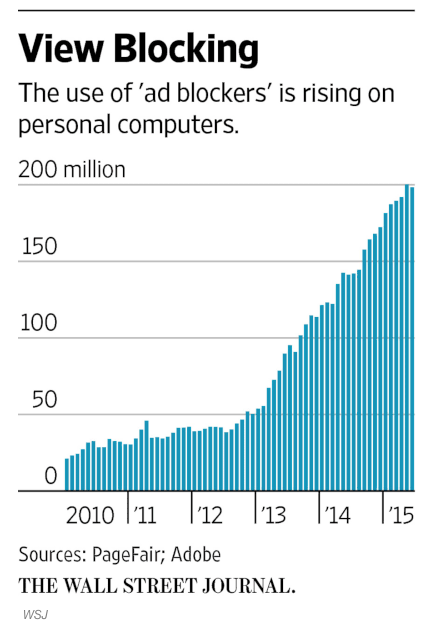
Putting such “ad blockers” within reach of hundreds of millions of iPhone and iPad users threatens to disrupt the $70 billion annual mobile-marketing business, where many publishers and tech firms hope to generate far more revenue from a growing mobile audience. If fewer users see ads, publishers—and other players such as ad networks—will reap less revenue.

But it seems « Buy Android! » is not the solution either, as pressure mounts for Android to also support ad blockers:
Apple Wages War On Mobile Advertising
31 Aug. 2015 — Yahoo Finance
The shift has spawned an entirely new industry focused on growing a companies’ revenue based on mobile advertising. However, Apple’s latest initiative could mark the beginning of the end for mobile advertisers.
Great Customers
Apple’s offer to block advertisements is likely to put pressure on Google Inc (NASDAQ: GOOG)’s Android system to do the same.
However, since Google makes a large chunk of its revenue through advertising, that could pose a problem. Not only will more mobile users be expecting fast loading pages and fewer ads, but removing Apple customers from the pool of potential ad viewers will be detrimental to advertisers as well.
Apple customers tend to spend more than their Google counterparts, making them an attractive audience. However, the new iOS will take that group out of the mix and make them more difficult to reach.
In contrast, the New York Times celebrates its top 50 paywall stories
September 21, 2015

The New York Times is taking note of an important milestone, and we’d like our readers to be a part of it.
We recently passed one million digital-only subscribers, reflecting the remarkable bond that The Times has built with readers on our digital platforms. They join our 1.1 million print-and-digital subscribers.


